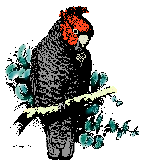By Katherine Harmon | Feb 1, 2011 08:01 PM | 0
Whether they are finding love in a flock or a lab, female Gouldian finches
(Erythrura gouldiae) know what they're looking for: a fit male with head
feathers that match their own. And the females that don't end up with a
desirable mate are slower to lay eggs and wind up more physiologically
stressed, according to new research.
Animal species that bond in monogamous pairs-whether for life or just for a
season-are often assumed to have found a perfectly satisfactory mate for
their tastes. But, such a presumption is likely "naive," contend researchers
behind the new finch work. "This logic would be akin to assuming that only
women as attractive as Angelina Jolie find a man such as Brad Pitt
attractive," they noted in their paper published online February 1 in
Proceedings of the Royal Society B: Biological Sciences. So just as it is in
the human world that "only one high-quality woman is able to socially pair
with Brad Pitt" (at least as of late), pair-bonded animals also likely often
have to settle for a less-than-ideal mate, the researchers point out in the
study.
As a species that usually lives for less than three years and-breeds only
once or twice a year-female Gouldian finches have a keen interest in picking
the best mate each season. To do this, they rely in large part on the
shorthand signal of a colorful male's head feathers (which are either red or
black) to indicate the likely fitness of their prospective offspring.
Offspring from mixed pairs have a 40 to 80 percent higher mortality rate, so
males with a matching head color are most attractive. In the wild, these two
color types often coexist in uneven numbers, leaving some females to "face
the choice of breeding with an incompatible partner or not breeding at all,"
the researchers, led by Simon Griffith, of Macquarie University's biology
department, noted in their study.
To assess the impact of this decision, Griffith and his team set out to try
to measure "the extent of female 'satisfaction' with her social partner." To
do this, they monitored several waves of pairing couples in a large aviary
(with 20 to 28 birds per group) and in 100 more pairings in controlled
single-pair lab cages. In both situations, females who ended up with a mate
with a different head color were slower to lay eggs (by 20 days to a month)
and had three- to four-times higher levels of the animal stress hormone
corticosterone. And especially for females in the forced-pair cage
experiments, the stress of being faced with an unattractive mate set in
quickly, leading to "significantly higher conticosterone" within 12 hours of
pairing. The speed of this stress response, the researchers suggest, "was
not driven by indirect effects of male behavior on the female, but rather by
her initial perception of him."
The similarity of response in an open-selection aviary versus a pre-selected
single-pair cage (where females were each paired once with a compatible and
incompatible male) suggests that the female's reaction has less to do with
her option to choose than with the mate she ends up with.
So although the birds might not be consciously weighing their options and
rationalizing their decision (or lot), the researchers suggest the finches
were revealing some level of "internal conflict," they note. "These females
are making the best of a bad situation and are dissatisfied with their
partner although he does represent a better option than not breeding at
all."
But these vexed female finches are not given entirely to avifaunal despair.
In fact, the authors posit, the physiological stress response might be a way
of prompting them to other adaptive behaviors, such as investing less in
that season's offspring or looking for love outside of the nest.
http://www.scientificamerican.com/blog/post.cfm?id=bush-league-male-mates-stress-out-f-2011-02-01&WT.mc_id=SA_CAT_EVO_20110207
*******************************************************************************************************
This is the email announcement and discussion list of the Canberra
Ornithologists Group.
Please ensure that emails posted to the list are less than 100 kb in size.
When subscribing or unsubscribing, please insert the word 'Subscribe' or
'Unsubscribe', as applicable, in the email's subject line.
List-Post: <>
List-Help: <>
List-Unsubscribe: <>
List-Subscribe: <>
List archive: <http://bioacoustics.cse.unsw.edu.au/archives/html/canberrabirds>
List manager: David McDonald, email
<>
|

